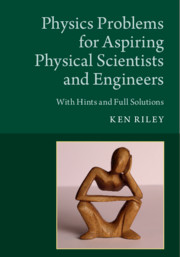
- Publisher:
- Cambridge University Press
- Online publication date:
- January 2019
- Print publication year:
- 2019
- Online ISBN:
- 9781108592123

An essential part of studying to become a physical scientist or engineer is learning how to solve problems. This book contains over 200 appropriate physics problems with hints and full solutions. The author demonstrates how to break down a problem into its essential components, and how to chart a course through them to a solution. With problem-solving skills being essential for any physical scientist or engineer, this book will be invaluable to potential and current undergraduates seeking a career in these fields. The book is divided into three parts: questions, hints and solutions. The questions section is subdivided into 15 chapters, each centred on a different area of physics, from elementary particles, through classical physics, to cosmology. The second section provides brief hints, whilst the third sets out full and explicit solutions to each problem. Most begin with thoughts that students might have after reading a problem, allowing the reader to understand which questions they should be asking themselves when faced with unfamiliar situations.
‘Useful to both students and teachers of physics at introductory levels, this book is a compendium of some 200 problems with some questions on physical concepts … Students preparing for entrance examinations or teachers looking for interesting questions will find this compendium useful and enjoyable.’
N. Sadanand Source: Choice
‘I am personally convinced since some time that this is just the right way to train motivated students … I decided to prove the effectiveness of [this approach] … once a week I gave two or three problems from Riley’s book to selected final years college students … Some problems were solved (not always closely following the solution presented in the book) with no hint supplied … Some of them (few) effectively required the hint supplied in the second part of the book … Finally, few problems were left unsolved. I gave the students the solution proposed in the third part of the book, without any explanation or presentation on my part … Good students interested in becoming scientific innovators and developers of the future (as well as good teachers looking to the future) wanted.’
Salvatore Esposito Source: Contemporary Physics
 Loading metrics...
Loading metrics...
* Views captured on Cambridge Core between #date#. This data will be updated every 24 hours.
Usage data cannot currently be displayed.